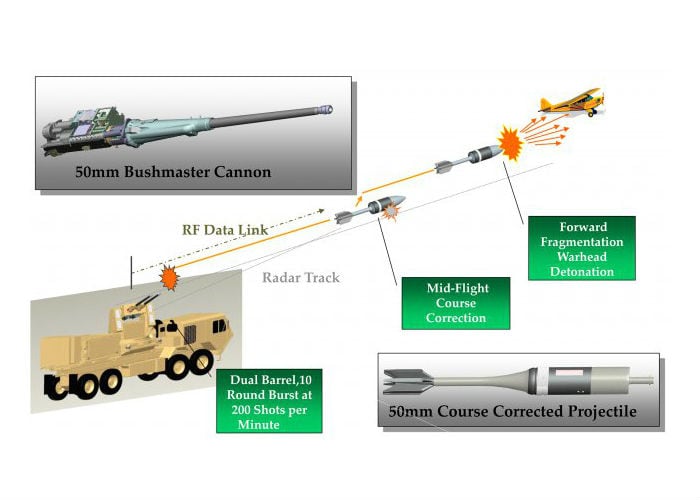An experimental Army anti-drone gun shot down two unmanned aerial vehiclesUAVs during a demonstration in August.
The August 19 intercepts, at Yuma Proving Ground, Arizona, occurred at over a kilometer range and about 1,500 meters high, according to an Army news release.
The weapon is part of the Counter-Rocket, Artillery, and Mortar (C-RAM) program, which has opted for a missile-based system Indirect Fire Protection Capability Increment 2 Intercept Program of Record. But guns are being explored for other uses, such as downing UAVs.

The operational concept behind the Enhanced Area Protection and Survivability technology is to have a 50mm course-corrected projectile intercept an incoming threat. The warhead has a tantalum-tungsten alloy liner to form forward-propelled penetrators for defeat of rockets, artillery and mortars while steel-body fragments are designed to counter unmanned aerial systems.
Photo Credit: U.S. Army illustration
The gun system "envisions a 50-mm cannon to launch command-guided interceptors," the Army said. "The system uses a precision tracking radar interferometer as a sensor, a fire control computer, and a radio frequency transmitter and receiver to launch the projectile into an engagement 'basket.'"
The system "tracks both the incoming threat and interceptor, then computes an ideal trajectory correction for the interceptor to maximize probability of mission success. A thruster on the interceptor/projectile is used for course correction. The ground station uplinks the maneuver and detonation commands, while receiving downlinked assessment data.
"The interceptor takes the commands and computes the roll orientation and time to execute thruster and warhead detonation. The warhead has a tantalum-tungsten alloy liner to form forward propelled penetrators for defeat of C-RAM targets, and steel body fragments to counter unmanned aerial systems."
Michael Peck is a correspondent for Defense News and a columnist for the Center for European Policy Analysis. He holds an M.A. in political science from Rutgers University. Find him on X at @Mipeck1. His email is mikedefense1@gmail.com.








